Kotlin vs Python: What Are Their Main Differences?
Are you faced with a dilemma and trying to decide which is the ideal programming language to start your first steps in the world of programming?
If the answer is yes, then today's guide is for you.
We will be discussing two popular programming languages, Python and Kotlin.
In this article, we'll cover:
What is Kotlin?
What is Python?
How do they differ from each other?
Let's start with two fundamental definitions.
What is Kotlin?
Kotlin is a statically typed programming language developed by JetBrains, first released in February 2016.
It is an open-source, high-level language that can operate and be used alongside Java.
Its code runs on the Java Virtual Machine (JVM), and Kotlin supports both object-oriented and functional programming.
What is Python?
Python is a popular object-oriented, high-level programming language with dynamic properties.
It is a general-purpose language with integrated data structures that was developed in February 1991 by Guido Van Rossum.
Due to its capabilities, Python is used in various fields, including artificial intelligence, machine learning, web development, and application development.
Now that we've seen some important aspects of each language separately, let's delve into a more detailed comparison.
Kotlin vs Python: Key Differences
Kotlin and Python, although both are highly used programming languages that support cross-platform, demonstrate some key differences.
.jpg)
Let’s analyze them in more detail below.
Difference #1: Ease of learning
For someone taking their first steps in programming, Python might seem more straightforward, accessible and easier to learn.
Python's syntax is concise, friendly, and simple, facilitating code readability and writing.
On the other hand, Kotlin has syntax similar to Java, making it more suitable for advanced programmers with a background in Java.
Difference #2: Usage
Python is a general-purpose language widely used in various fields, from rapid application development to popular applications like Uber, Spotify, and Instagram.
It has an extensive ecosystem with a vast collection of libraries and frameworks, making it suitable for web development, data analysis, machine learning, artificial intelligence, and more.
In contrast, Kotlin is mainly associated with Android app development and has been officially supported by Google as the preferred language for Android app developers since 2019.
Difference #3: Performance
Kotlin is a statically typed language that compiles to bytecode, running on the Java Virtual Machine (JVM). This results in performance comparable to Java.
Python, being an interpreted language, can be slower than statically typed languages like Kotlin.
However, Python leverages libraries such as NumPy and pandas to enhance performance in specific domains.
Difference #4: Popularity
Python is well-known for its widespread popularity and large programming community.
On the other hand, Kotlin, being relatively newer, has a smaller community and is less popular compared to Python.
As we can see in the following Google trends graph, Python (blue) shows an upward trend and much higher demand compared to Kotlin (red).
.jpg)
Also, according to the TIOBE Programming Community index, an index of programming language popularity, Python consistently maintains its position as the most popular programming language, while Kotlin is less popular but has been rising in rank.
More specifically, Kotlin is ranked 18th in popularity, up from 28th in October 2022.

Ramping Up
In summary, we've thoroughly discussed Python and Kotlin, analyzing their differences.
The choice between Python and Kotlin depends on individual needs and preferences.
From a more objective angle, If you are a beginner or aiming for a career in data science, Python offers more opportunities and broader employment prospects.
If you want to learn more about Python, the most popular programming language, follow us and we will keep you posted!


.jpg)